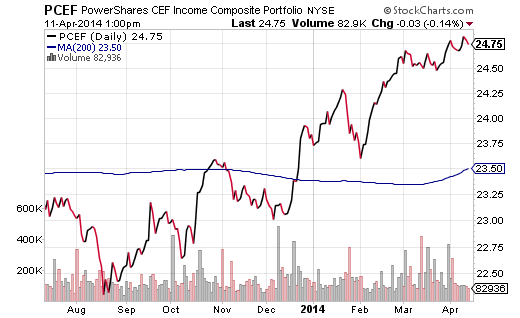Before exchange-traded funds (ETFs) became widely accepted, the closed end fund, or CEF, offered investors the ability to trade a diversified investment throughout the day. CEFs have a fixed number of shares such that supply and demand determines share price. Yet those prices frequently trade at a significant discount or premium to the actual underlying holdings (a.k.a. net asset value). In contrast, ETFs do not have a fixed number of shares. Discounts and premiums are typically insignificant such that market prices tend to reflect the actual underlying net asset value.
The fact that both structures are tradeable throughout a session is an attractive feature for those who, like myself, value liquidity. On the other hand, I also appreciate low costs, tax-efficiency and transparency. Most ETFs track passive indexes (e.g., S&P 500, MSCI EAFE, Barclays Aggregate Bond, etc.), carving out the expenses and tax consequences associated with active fund manager participation. What’s more, an investor usually knows what a traditional ETF is holding because an index outlines its component parts. In contrast, it may be difficult to know precisely what a CEF owns at a given point in time and CEF expenses regularly exceed 1%.
Of course, CEF enthusiasts can point to a variety of advantages that many commentators disregard altogether. For example, yield-oriented investors of CEFs often look forward to high-yielding monthly distributions that blow away the competition. How do CEFs do it? They may use leverage to enhance potential returns. Granted, the leverage can increase price volatility when a particular market is backtracking. Nevertheless, there are those who believe that the super-sized monthly distributions offset short-term price movement; many simply anticipate that price stability and/or appreciation will occur over the long period.
In sum, the primary advantage of CEF investing is its yield enhancement in a world where yield is difficult to come by. The higher yields may serve as an offset to onerous expenses as well as shorter-term price volatility. Still, how can you diversify the risk associated with the possibility of selecting an exceptionally poor CEF? Perhaps ironically, one answer has been the “fund of fund” approach where an ETF owns 30 or more CEFs.
The PowerShares CEF Income Composite Portfolio Fund (PCEF.K) is the first of its kind, amassing more than $525 million in assets in just over four years. It tracks an index that is made up of 150 CEFs comprised of taxable investment grade income securities, taxable high yield income securities as well as taxable equity options. As one might anticipate, the 1.77% total expense ratio hardly sounds like an ETF product at all, but supporters can point to monthly distributions at an SEC 30-day yield of 7.4%. From a technical perspective over an approximate 9-month span, PCEF demonstrates a solid uptrend and has provided a 7.14% return. It is presently on pace to surpass its annualized yield projections net of fees.

However, PCEF is no longer the only “ETF-of-CEF” game in town. The Yield Shares High Income ETF (YYY) debuted back on 6/21/13, accumulating close to $35 million in nine-and-a-half months. YYY applies a more focused approach. Rather than tracking a substantial portion of the CEF universe in the aforementioned security areas, YYY tracks an index that ranks the top 30 CEFs without regard to security type on net asset value discount, liquidity as well as fund yield. It follows that securities include, but are not limited to, foreign equities, domestic equities, debt, dividend payers, non-dividend payers and so forth. Weightings within YYY are capped at 4.25% at the initial stage of index rebalancing.
How has YYY fared? With an expense ratio (1.65%) that is lower than PCEF and an SEC 30-day yield (8.4%) that is higher than PCEF, the newer fund has picked up roughly 9.2%.

Granted, evaluating the performance of PCEF as it compares to the newcomer (YYY) is not an apples-to-apples comparison. Each tracks a unique index. Also, PCEF is primarily situated in fixed income whereas YYY can invest in anything that the CEF world has to offer. That said, the primary objective for those who covet CEF exposure tends to be high monthly dividends. The multi-asset approach of YYY offers asset type diversification as well as an aggressive yield pursuit worthy of consideration for high monthly income seekers.
It should be noted that the average daily dollar volume for YYY is $500,000. Extremely active traders who tend to look for $1,000,000 or more in average daily dollar volume might not be good candidates for this fund just yet. For those who may have a particular price point in mind — for those who expect to hold for a longer period to pursue the aggressive yield — YYY dollar volume is sufficient.
Disclosure: Gary Gordon, MS, CFP is the president of Pacific Park Financial, Inc., a Registered Investment Adviser with the SEC. Gary Gordon, Pacific Park Financial, Inc, and/or its clients may hold positions in the ETFs, mutual funds, and/or any investment asset mentioned above. The commentary does not constitute individualized investment advice. The opinions offered herein are not personalized recommendations to buy, sell or hold securities. At times, issuers of exchange-traded products compensate Pacific Park Financial, Inc. or its subsidiaries for advertising at the ETF Expert web site. ETF Expert content is created independently of any advertising relationships.
